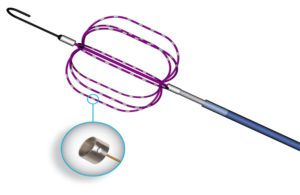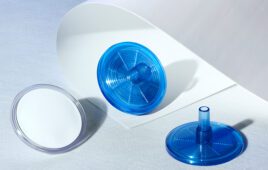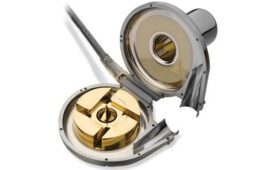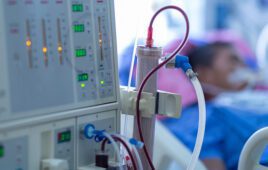While manual resistance welding is common in the device manufacturing industry,
automated electrode welding processes can enhance the consistency, quality, performance and efficiency of electrode ring assemblies.
Paul McCormick, Integer

Electrophysiology basket catheter with ring electrode. (Image courtesy of Integer.)
Multielectrode electrophysiology (EP) catheters have become the new mainstay for the mapping of complex arrhythmias. Advanced electrogram mapping is delivering breakthrough results in the diagnosis and treatment of one of the most common arrhythmias – atrial fibrillation (Afib).
As this market grows, demand for improved electrogram mapping is fueling the innovation of new high-density mapping catheters. While much of the focus in high-density mapping has been on the spline and basket assemblies, the electrode and wire sub-assembly is an equally important, but often overlooked, component of the finished device.
Precise electrode and wire assemblies are increasingly important because accurate mapping requires greater electrode density and optimal electrode connections, yet manual resistance welding is still commonly used in device manufacturing. The resistance welding process falls short in some key areas, including:
-
- Multiple testing cycles. Due to potential variation in electrode assembly performance, product performance is typically more complicated to test, inspect and resolve.
- Increased cost. Reliance on labor-intensive processes with higher scrap rates increases the cost of goods sold and reduces the device supplier’s ability to competitively price the product.
- A higher rate of product failures. During the manual resistance welding process, the risk of weld failures is greater. This hampers electrical performance and has the potential to negatively affect product performance in the field.
Automated electrode welding processes have become a more effective way to produce higher electrode densities. Compared to manual resistance welding, automated laser welding can provide higher-quality electrode and wire assemblies and greater precision and manufacturing efficiency, delivering more reliable EP catheter performance.
Laser welding also produces a flatter and smaller weld spot than typical resistance welding (.003 in. versus .007 in. for typical resistance weld). This creates additional space for precise positioning of multiple wires or extrusions inside the electrode ring to support the electrode miniaturization needed for high-electrode-density catheters while reducing the risk for fluid leaks.
The automated laser welding process also boosts manufacturing efficiency. In development, it strengthens reliability by minimizing the number of variables to investigate, evaluate and troubleshoot during the design process. Automated quality control also minimizes the potential for waste and product failures downstream in the supply chain – in the testing of spline assemblies or finished EP mapping catheters – where the cost of repairing poor quality is greater.
Outsourcing complex EP electrode assemblies allows device manufacturers to maintain their focus on high-value initiatives while leveraging core manufacturing capabilities from an outsourcing partner.
Paul McCormick is a senior research and development engineer for Integer. He is responsible for product and process design and development for new internal and co-development product opportunities. Most recently, his projects have focused on process development for electrophysiology catheters.
The opinions expressed in this blog post are the author’s only and do not necessarily reflect those of Medical Design and Outsourcing or its employees.




